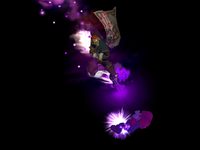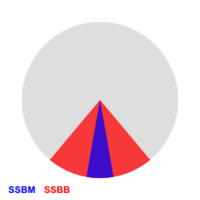Spike: Difference between revisions
mNo edit summary |
|||
| Line 3: | Line 3: | ||
[[Image:Wizard's Foot Spike.png|thumb|An image of Ganondorf's spike, during [[Wizard's Foot]], in ''Melee''.]] | [[Image:Wizard's Foot Spike.png|thumb|An image of Ganondorf's spike, during [[Wizard's Foot]], in ''Melee''.]] | ||
A '''spike''' is an attack that sends the opponent downwards but cannot have its knockback interrupted via [[meteor cancel]]ling. As a result, they are significantly more dangerous than the similar [[meteor smash]]. | A '''spike''' is an attack that sends the opponent downwards but cannot have its knockback interrupted via [[meteor cancel]]ling. As a result, they are significantly more dangerous than the similar [[meteor smash]]. Just like a meteor smash, it has the similar effects on grounded opponents as opposed to aerial opponents when they connect; this true for the fact that spikes also cannot be [[Crouch cancel|crouch-cancelled]]. | ||
In most games of the ''Super Smash Bros.'' series, there are no spikes - all attacks that hit downwards are meteor smashes. However, in ''[[Super Smash Bros. Melee]]'', a technical oversight results in two types of downwards attacks - those that can be meteor cancelled, and those that cannot - the first group are meteor smashes, while the second group are spikes. Despite this clear distinction, many players erroneously use the term "spike" to mean "meteor smash" regardless of the game, referring to spikes as "true spikes" to reflect their inability to be cancelled. | In most games of the ''Super Smash Bros.'' series, there are no spikes - all attacks that hit downwards are meteor smashes. However, in ''[[Super Smash Bros. Melee]]'', a technical oversight results in two types of downwards attacks - those that can be meteor cancelled, and those that cannot - the first group are meteor smashes, while the second group are spikes. Despite this clear distinction, many players erroneously use the term "spike" to mean "meteor smash" regardless of the game, referring to spikes as "true spikes" to reflect their inability to be cancelled. | ||
Revision as of 20:09, May 5, 2017
- This article is about the technical definition of "spike". For information about the mechanic commonly incorrectly referred to as a spike, see meteor smash. For the stage element, see Spike (stage element).

A spike is an attack that sends the opponent downwards but cannot have its knockback interrupted via meteor cancelling. As a result, they are significantly more dangerous than the similar meteor smash. Just like a meteor smash, it has the similar effects on grounded opponents as opposed to aerial opponents when they connect; this true for the fact that spikes also cannot be crouch-cancelled.
In most games of the Super Smash Bros. series, there are no spikes - all attacks that hit downwards are meteor smashes. However, in Super Smash Bros. Melee, a technical oversight results in two types of downwards attacks - those that can be meteor cancelled, and those that cannot - the first group are meteor smashes, while the second group are spikes. Despite this clear distinction, many players erroneously use the term "spike" to mean "meteor smash" regardless of the game, referring to spikes as "true spikes" to reflect their inability to be cancelled.
Technical information
In Melee, hitboxes that send opponents at an angle between 260 and 280 degrees are recognized by the game as meteor smashes. However, there exist some hitboxes that send opponents downward, but at a diagonal trajectory outside this angle window (for example, 290 degrees). As a result, the game does not recognize them as meteor smashes, and are thus unable to be meteor cancelled.
It is most likely due to the degree/angle they are sent at being akin to the volleyball strategy of the same name (instead of directly downward), is possibly why they are named as "spikes"; spikes in volleyball are also unable to normally be returned, in the same way spikes in Smash Bros. cannot be meteor cancelled.
In Brawl however, the angle window for what the game recognizes as meteor smashes was increased to being between 230 and 310 degrees, enough so to cover the downward diagonal trajectory the spikes in Melee had. As a result, the spiking hitboxes in Melee that retained their trajectories are recognized as meteor smashes in Brawl, and are capable of being meteor cancelled.
Usage
Spikes have the benefits of meteor smashes: knocking the opponent downward with gravity assisting the knockback. But they do so without the drawback of the opponent having the ability to completely negate the knockback with a jump or recovery move. As a result, spikes are extremely effective KO moves in edge guarding situations - recovering from even moderately powerful spikes is usually impossible above extremely low percents. Because of this, many smashers who main characters with practical spikes try to integrate spikes into play as often as possible.
List of spikes in Super Smash Bros. Melee
Characters with usable spikes
- Captain Falcon - Down aerial; of its three hitboxes, the topmost of them produces the so-called nipple spike. This hitbox produces the most powerful spike in Melee, but its small size makes it impractical to use; while it can potentially be comboed into, the Knee is generally a more practical option as a combo finisher.
- Falco - Down aerial; while the spike lasts for its entire duration in NTSC regions, only the first half of the attack spikes in PAL regions. The attack is powerful, effective, and is very easy to land due to its low start-up lag; the attack can also be easily comboed into from Falco's Shine, and it can act as a very effective combo starter on grounded opponents when used by itself. However, the attack's long duration makes it extremely risky to use offstage, due to Falco's high falling speed and poor recovery.
- Fox - Down aerial, with all of its hits being spikes. The attack's spike properties, however, are extremely weak and uniquely have set knockback, making it almost impossible to KO with unless there is a significant handicap advantage on the opponent. However, this also makes the attack useful for comboing, especially on floaty characters.
- Ganondorf - Wizard's Foot when used in the air, with all of its hitboxes spiking opponents. Despite its high power and long duration, the attack has relatively high start-up lag, and when used off the ledge, it forces Ganondorf into an inconvenient recovery position exacerbated by his easily edge-guarded recovery. Additionally, recovery moves that possess damaging hitboxes also prevent Ganondorf from landing the move, as the recovery hitboxes will hit and disrupt Ganondorf before the hitboxes of Wizard's Foot connects, making the move unfeasible for intercepting most recovery moves. While using it towards the centre of a stage can alleviate the difficulties with recovering, Ganondorf's other edgeguarding options, such as his up aerial, are generally more practical and efficient to use.
- Marth - Down aerial, when tipped; its angle was adjusted in PAL regions to a meteor smash angle, thus being a meteor smash in PAL regions. With its high power, long reach and very low start-up lag, it can be easily landed, and can effectively KO offstage opponents at low-mid damages, particularly in combination with the Ken Combo. The attack can also potentially tech-chase grounded opponents, but its high ending lag makes it of high risk to use off the ledge.
- Roy - Up smash, when an airborne opponent is hit with the tip of the sword in its first few frames. The attack, however, is impractical for edgeguarding, as the spiking hitbox is small and has a short duration; Roy also cannot easily combo into the attack.
Other spikes
- Dr. Mario's up smash is a spike, but only on grounded opponents; aerial opponents are hit upwards instead. The attack has an angle of 259, as close to the meteor detection window as it can get without being considered a meteor smash.
- Master Hand and Crazy Hand - The lower hitboxes of the Finger Drill and the Finger Walk are spikes designed to keep targets in place for the next part of the move.
- Poké Ball Pokémon:
- Runaway Tour Bus in Onett.
Spikes in other games
Meteor cancelling does not exist in the original Super Smash Bros., and was removed in Super Smash Bros. 4, meaning that all meteor smashes in said games are functionally equivalent to spikes.
In Brawl and Smash 4, several boss and enemy hitboxes have angles such as -70 and -90, which appear to be intentional ways of circumventing the meteor smash recognition window for the former game, making such attacks spikes. As playable characters do not possess any such attacks, however, spikes are considered a removed element in such games.
List of spikes by enemies and bosses in Brawl
- Petey - downwards portion of jumps
- Rayquaza - start of digging and explosion attacks
- Ticken - ground pound attack (aerial portion)
List of spikes by enemies and bosses in SSB4
Note that at the present time, while most hitboxes are known, their associated moves may not be.
- Bonkers
- Bulborb
- Clubberskull
- Master Giant
- Megonta
- Skuttler Mage - triple swipe (hit 2)
- Stalfos
See also
- Meteor smash - an attack that deals downward knockback but that can be recovered from through meteor cancelling.
- Semi-spike - an attack that hits the opponent at a low horizontal angle that hinders recovery opportunities.
- Stage spike - a spike performed by bouncing an opponent off an angled part of a stage to send them downward.

